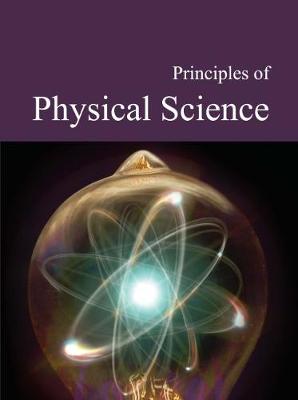Principles of Science
3 total works
This new resource introduces students and researchers to the fundamentals of chemistry. Entries are written in easy-to-understand language, so readers can use these entries as a solid starting off point to develop a thorough understanding of this often time confusing subject matter.
This reference work begins with a comprehensive introduction to the field, starting with man's earliest understanding of the primary substance of life and concluding with a discussion of chemistry as the "central science" and touching on the exciting contemporary research being conducted around such fascinating amterial as grapheme and buckyballs.
Principles of Chemistry includes 128 entries ranging from Acid Anhydrides to Zone Refining. All entries are arranged in an A to Z order, making it easy to find the topic of interest. Each entry includes: related fields of study to illustrate the connections between the various branches of chemistry;a brief, concrete summary of the topic and how the entry was organized; principal terms that are fundamental to the discussion and to understanding the concepts presented; illustrations that clarify difficult concepts via models, diagrams, and charts of such key topics as the relationship between acid and bases, molecular structures, bonds, and reactions; equations that demonstrate how chemical formulas are written, how equations are balanced, and other important functions; photographs of significant contributors to the study of chemistry; sample problems that further demonstrate the concerpt presented; and further reading list that relates to the entry.
Entries are arranged into easy-to-use subject areas. Salem Press' Principles of Chemistry covers:
• Chemical Reactions - covers basic terms and concepts including Biochemistry, Diffusion, DNA & RNA Synthesis, Hydrolysis, Osmosis, Pericyclic Reactions, Redox Reactions and more.
• Reaction Calculations - provides detail on Avogadro's Law, Balancing Equations, Conservation of Mass, Definite Proportions, Molecular Formula, Multitple Proportions, Percentage Composition, and Stoichiometry.
• Elements, Molecules, & Compounds - covers Acids & Bases, Alkali Metals, Amino Acids, Atoms, Chemical Energy, Inert Gases, Man-made Elements, Molecular Formula, Neutrons, Protons, Reading the Periodic Table, Radioactive Elements, Salts, Toxins and many more.
• Organic Chemistry: Functional Matter - provides an explanation of Acid Chloride, Alkynes, Benzene & Other Rings, Diols, Ketones, Phenols, Reaction Mechanisms and Reaction Rates.
• Properties of Matter - covers Aromaticity, Atomic Number, Ductility, Half-Life, Lewis Structure, Litmus Test, Molarity, Orbitals, Radioactive Decay, Spectroscopy, Sublimation, and many more.
This new resource will be a helpful tool for students and researchers who are just beginning their study of chemistry and need a solid background of the key terms and elements in the field. A must for all high school and undergraduate science programs.
This reference work begins with a comprehensive introduction to the field, starting with man's earliest understanding of the primary substance of life and concluding with a discussion of chemistry as the "central science" and touching on the exciting contemporary research being conducted around such fascinating amterial as grapheme and buckyballs.
Principles of Chemistry includes 128 entries ranging from Acid Anhydrides to Zone Refining. All entries are arranged in an A to Z order, making it easy to find the topic of interest. Each entry includes: related fields of study to illustrate the connections between the various branches of chemistry;a brief, concrete summary of the topic and how the entry was organized; principal terms that are fundamental to the discussion and to understanding the concepts presented; illustrations that clarify difficult concepts via models, diagrams, and charts of such key topics as the relationship between acid and bases, molecular structures, bonds, and reactions; equations that demonstrate how chemical formulas are written, how equations are balanced, and other important functions; photographs of significant contributors to the study of chemistry; sample problems that further demonstrate the concerpt presented; and further reading list that relates to the entry.
Entries are arranged into easy-to-use subject areas. Salem Press' Principles of Chemistry covers:
• Chemical Reactions - covers basic terms and concepts including Biochemistry, Diffusion, DNA & RNA Synthesis, Hydrolysis, Osmosis, Pericyclic Reactions, Redox Reactions and more.
• Reaction Calculations - provides detail on Avogadro's Law, Balancing Equations, Conservation of Mass, Definite Proportions, Molecular Formula, Multitple Proportions, Percentage Composition, and Stoichiometry.
• Elements, Molecules, & Compounds - covers Acids & Bases, Alkali Metals, Amino Acids, Atoms, Chemical Energy, Inert Gases, Man-made Elements, Molecular Formula, Neutrons, Protons, Reading the Periodic Table, Radioactive Elements, Salts, Toxins and many more.
• Organic Chemistry: Functional Matter - provides an explanation of Acid Chloride, Alkynes, Benzene & Other Rings, Diols, Ketones, Phenols, Reaction Mechanisms and Reaction Rates.
• Properties of Matter - covers Aromaticity, Atomic Number, Ductility, Half-Life, Lewis Structure, Litmus Test, Molarity, Orbitals, Radioactive Decay, Spectroscopy, Sublimation, and many more.
This new resource will be a helpful tool for students and researchers who are just beginning their study of chemistry and need a solid background of the key terms and elements in the field. A must for all high school and undergraduate science programs.
Provides students and researchers with an easy-to-understand introduction to the fundamentals of physics.
This new resource introduces students and researchers to the fundamentals of physics. Entries are written in easy-to-understand language, so readers can use these entries as a solid starting-off point to develop a thorough understanding of this oftentimes confusing subject matter.
This edition includes 142 entries ranging from Aberrations to X-rays. All entries are arranged in an A to Z order, making it easy to find the topic of interest. Each entry includes related fields of study to illustrate the connections between the various branches of physics, including acoustics, high energy physics, psychophysics, quantum electrodynamics, and nanotechnology; a brief, concrete summary of the topic and how the entry was organized; principal terms that are fundamental to the discussion and to understanding the concepts presented; illustrations that clarify difficult concepts via models, diagrams, and charts of such key topics as blackbody radiation, Bernouilli's principle, and Higgs boson; equations that demonstrate how to determine mechanical advantage, understand the ideal gas law, the fundamentals of quantum mechanics, and Einstein's famous mass-energy equation-E=mc2; photographs of significant contributors to the study of physics; sample problems that further demonstrate the concept, law or constant presented; and biography lists that relates to the entry. Entries range from one to five pages in length.
Entries are arranged into easy-to-use subject areas. Salem Press’ Principles of Science: Physics covers:
• Absorption
• Bohr atom
• Light waves
• Prisms
• Ultrasound
Principles of Physics back matter is another valuable resource which includes: The Standard Model; Nobel Notes; Nobel Prize Laureates; Pre-Nobel Notables; Physics Constants; Physic Laws; Glossary; General bibliography; and a Subject Index.
This new resource is a helpful tool for students and researchers who are just beginning their study of chemistry and need a solid background of the key terms and elements in the field. A must for all high school and undergraduate science programs.
This new resource introduces students and researchers to the fundamentals of physics. Entries are written in easy-to-understand language, so readers can use these entries as a solid starting-off point to develop a thorough understanding of this oftentimes confusing subject matter.
This edition includes 142 entries ranging from Aberrations to X-rays. All entries are arranged in an A to Z order, making it easy to find the topic of interest. Each entry includes related fields of study to illustrate the connections between the various branches of physics, including acoustics, high energy physics, psychophysics, quantum electrodynamics, and nanotechnology; a brief, concrete summary of the topic and how the entry was organized; principal terms that are fundamental to the discussion and to understanding the concepts presented; illustrations that clarify difficult concepts via models, diagrams, and charts of such key topics as blackbody radiation, Bernouilli's principle, and Higgs boson; equations that demonstrate how to determine mechanical advantage, understand the ideal gas law, the fundamentals of quantum mechanics, and Einstein's famous mass-energy equation-E=mc2; photographs of significant contributors to the study of physics; sample problems that further demonstrate the concept, law or constant presented; and biography lists that relates to the entry. Entries range from one to five pages in length.
Entries are arranged into easy-to-use subject areas. Salem Press’ Principles of Science: Physics covers:
• Absorption
• Bohr atom
• Light waves
• Prisms
• Ultrasound
Principles of Physics back matter is another valuable resource which includes: The Standard Model; Nobel Notes; Nobel Prize Laureates; Pre-Nobel Notables; Physics Constants; Physic Laws; Glossary; General bibliography; and a Subject Index.
This new resource is a helpful tool for students and researchers who are just beginning their study of chemistry and need a solid background of the key terms and elements in the field. A must for all high school and undergraduate science programs.
Provides students and researchers with an easy-to-understand introduction to the fundamentals of physical science.
This helpful resource provides high school and undergraduate researchers with a solid foundation to begin their study of physical science. The volume begins with a helpful introduction to the field, followed by over 100 detailed entries. Entries range from 1-5 pages in length and include a detailed overview of the topic, written in clear, understandable language. Entries also include key terms, related fields and are further supplemented with photos, illustrations, charts, models and diagrams.
Coverage in this volume is diverse, providing helpful guidance to the full spectrum of physical science studies, including:
This helpful resource provides high school and undergraduate researchers with a solid foundation to begin their study of physical science. The volume begins with a helpful introduction to the field, followed by over 100 detailed entries. Entries range from 1-5 pages in length and include a detailed overview of the topic, written in clear, understandable language. Entries also include key terms, related fields and are further supplemented with photos, illustrations, charts, models and diagrams.
Coverage in this volume is diverse, providing helpful guidance to the full spectrum of physical science studies, including:
- Properties & States of Matter
- Properties of Elements
- Chemical Bonding & Equations
- Gravity
- Force, Motion & Power
- Energy
- Electricity
- Magnetic Forces
- Heat & Termperature
- Nuclear Energy
- ... and so much more


